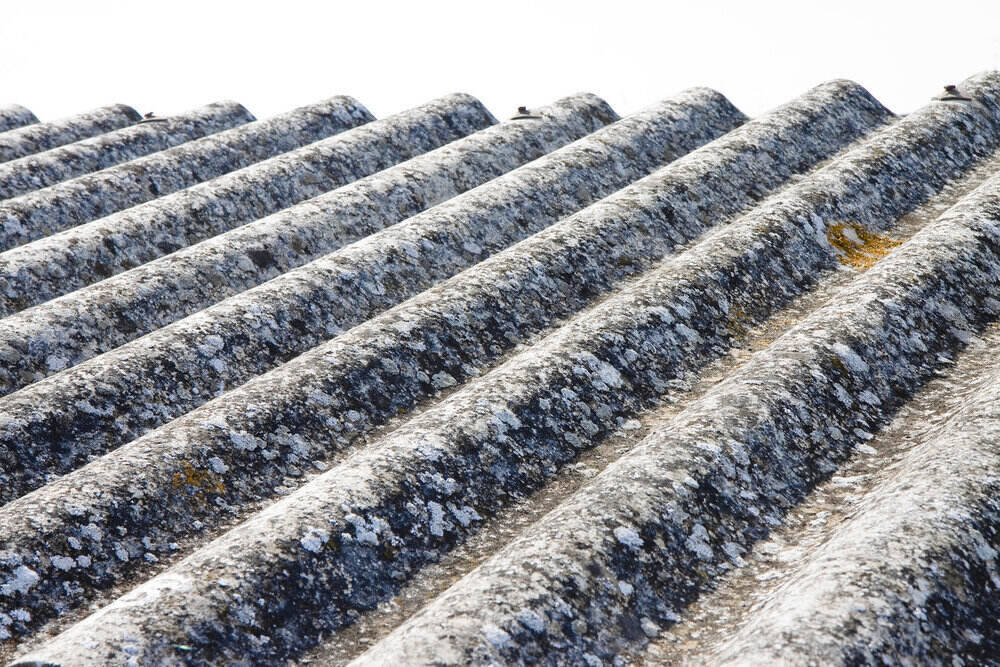Your Complete Asbestos Removal Guide

What is Asbestos & Where Can You Find It?
Asbestos, a toxic mineral once widely used in a variety of building products, presents a potential health hazard in many residential, commercial, and public buildings. The Environmental Protection Agency (EPA) reports that it can cause such serious health problems such as lung cancer, mesothelioma, and asbestosis. Homeowners should be aware that it can be found in the following places:
- Floor tiles and linoleum
- Attic and wall insulation
- Pipe and boiler insulation
- Joint compound associated with sheetrock walls or ceilings
- Surface coatings such as textured paint (i.e. popcorn ceilings)
- Glues and adhesives
- Exterior cementitious siding
- Roofing, shingles, and sealant
In other words, you can find asbestos on practically any building material in your home, but there are exceptions, such as wood, glass, fiber glass, metal, and brick. One of the most common places for asbestos to be present is on basement pipe and boiler insulation.
Asbestos pipe and boiler insulation is considered a friable material, which poses a higher level of concern since the chances of exposure or a release of asbestos is higher than materials that are considered non-friable, such as floor tiles or linoleums.
What is the difference between friable and non-friable?
- Friable material is a lose matrix that allows dust and particles to easily be released into the air with simple hand pressure. Special care should be taken when dealing with friable material.
- Non-friable materials cannot become friable unless they are sanded, cut, pulverized, or abraded in any manner. Non-friable material, when undisturbed, does not pose a health risk as long as it remains in its current state.
The general rule of thumb for friable material is to leave it alone, but if you must repair or remove it, it’s best to call the professionals.
More recently, asbestos has been showing up in joint compound, also known as drywall mud, which is used when hanging sheetrock.
So, why is it even in your house in the first place? Asbestos has long been used in building materials because it’s strong, durable, and has fire-resistant properties.
There are three main types of asbestos with chrysotile being the most common form and the easiest to wet during removal. Amosite and crocidolite are harder to wet, which makes abatement and elimination more of a challenge.
When Should You Test for Asbestos?
You should seek out a certified or trained asbestos inspector if you’re about to embark on any type of renovation or demolition project. For example, if you’re about to revamp your kitchen, you should have any suspect materials in that area tested.
You might also consider testing for asbestos if you’re about to put your house on the market, or if you’re buying a home and an inspector finds suspected asbestos. Many home inspectors, however, have a disclaimer explaining that it is not their responsibility to identify asbestos because a lot of homes built prior to the 1980s contain asbestos products.
If a homeowner plans on renovating their house and you suspect asbestos may be present, you need to find a certified or trained inspector, and once presence of the material is confirmed, you should seek out a professional asbestos removal company. It’s extremely important to remove this hazard, prior to renovation, from your home since inhaling asbestos fibers that may become airborne as result of the renovation can increase your risk of lung cancer and cause serious diseases such as asbestosis and mesothelioma. Plus, symptoms of asbestos exposure can take up to 14 years to develop.
One of the biggest challenges with asbestos is that you can’t see or smell the potentially hazardous fiber. In most cases, exposure only occurs when the material that contains asbestos is disturbed or damaged in some way, which releases to particles and fibers into the air, according to the EPA.
Commercial businesses will typically follow an operations and maintenance plan to manage asbestos in their building or facility. The Asbestos Hazard Emergency Response Act (AHERA) requires that all K-12 public and private schools must have annual asbestos inspections. It’s not required for institutions of higher education, but typically most colleges and universities do the same.
Asbestos Removal From Start to Finish
Asbestos removal projects vary depending on the amount found and size of the structure, but here’s an example of a fairly common residential scenario in which a homeowner’s kitchen linoleum tested positive:
1. Clear the area. The homeowner is responsible for clearing the counters but can leave items in the cabinets.
2. Build a containment. The abatement contractor will build a containment area around the asbestos by hanging two sheets of 6 mil poly and two sheets of regular poly. The contractor will also cover critical barriers, such as windows, doors, and HVAC openings that are not being used.
3. Construct a decontamination unit. The abatement company will build three chambers: a clean room, shower, and dirty room.
4. Prepare asbestos containment.
- In the clean room, the contractor will change into a Tyvek asbestos protection suit and mask and walk through the shower and dirty room to the work area.
- When the contractor needs to leave the work area for any reason (lunch, a break, or the project is over), the contractor will leave the tools in the dirty room, take a full shower with the mask on, and then proceed to the clean room to change and remove the mask.
- As part of the containment, the abatement company will use a High Efficiency Particulate Air (HEPA) machine to create negative pressure. This means that the air coming out of the unit is cleaner than the air outside the work area. That air is brought outside through a tube.
5. Begin asbestos removal. The asbestos is wettened using a mixture of water and surfactant with hoses and pump sprays since there can be no dust in the work area. The asbestos is removed and put into two layers of pre-labeled bags that are sealed. The bags leave the work area the same way a worker would: The contractor takes them through the dirty room, washes them in the shower, and walks out through the clean room to an enclosed lined dumpster outside that has been brought to the area.
6. Have the area tested by an independent third-party hygiene firm. After the asbestos has been removed, there is a final step in which an independent third-party subcontractor will conduct a visual inspection and take air samples. The visual inspection is to ensure that all material has been removed and that no dust or debris is left behind. Abatement contractors should clean the area so it’s considered “cleaner than it was before they started.” The air sampling is designed to test the air for not only potential asbestos fibers, but also for evidence of non-asbestos fibers or dust, which shouldn’t present if the abatement engineering controls were properly used. In most cases, the hygienist can read the air samples on site.
7. Dispose of the asbestos. Finally, the abatement company will take the asbestos waste to a facility that is permitted to accept asbestos waste.
It’s also important to note that not all asbestos needs to be removed, especially if it’s in good condition. If you are walking on floor tiles that contain asbestos, but the tiles aren’t damaged in any way, you don’t have to remove the flooring.
Asbestos can also be repaired with wet wraps if the area in question contains 15% or less damaged material. If more than 15% of the area needs to be repaired, you should opt for complete removal. Special care should be taken when repairing asbestos containing material since the material may be friable and the risk may be higher for exposure.
Residential vs. Commercial Asbestos Removal
Removing asbestos from a residential kitchen typically takes a day or two with about 3-4 workers. Removal from commercial buildings can take at least a few months and average about 6 workers on the job. All asbestos removal projects, however, vary depending on the amount of material and where it’s found.
Is It Ever Safe to Remove Asbestos Yourself?
Asbestos removal regulations vary by state. In New Hampshire, for example, homeowners in a single-family, owner-occupied home may remove asbestos. They are legally required, however, to use an asbestos abatement company for proper disposal. In Massachusetts, all asbestos must be removed and disposed of by an abatement contractor.
Removal also comes down to whether the asbestos is friable or nonfriable. Since friable asbestos can be pulverized, this material should not be removed by the homeowner based on the higher chance of asbestos release. Special handling and materials are needed to safely abate this material.
Asbestos found in floor tiles would be considered nonfriable since you can’t easily crush the asbestos in your hand. Homeowners may remove non-friable asbestos if allowed by state protocol but disposal regulations must be followed.
If you’re considering removing asbestos yourself, it’s important to consult your state’s regulations. If you’re uncertain about whether you have the right equipment or can remove the asbestos safely, it’s best to call an abatement company that can do it properly. Plus, failing to remove the material securely can expose you and your family to these fibers, and it’s easy to spread asbestos without realizing it, as evidenced in this video.
How Much Does Asbestos Removal Cost?
There are a lot of factors that determine the cost of asbestos removal, including:
- Location of asbestos within the home or structure
- Amount and condition of the asbestos
- Location of the job itself
The average cost of asbestos removal for a residential project is $2,500, but remember — every project is different.
FAQs
Q: What Is the difference between friable and nonfriable asbestos?
A: Friable asbestos can be pulverized or crumbled in your hand, whereas nonfriable cannot. For example, asbestos found in floor tiles would be considered nonfriable since you can’t easily crush the asbestos. You should not remove friable asbestos, such as insulation on basement pipes, since homeowners don’t have the ability to remove the material safely. Homeowners can, however, remove friable asbestos if allowed by state regulations.
Q: How do you clean up asbestos?
A: Proper asbestos removal includes building a containment and decontamination unit, wearing appropriate protective gear, and using the right equipment, such as a HEPA machine and hoses to wet the material and then following established protocols for safe disposal.
Q: How much does asbestos testing cost?
A: It depends. Testing of a single-family home can cost between $1,000 and $1,500, but it largely depends on the number of samples taken. The baseline is usually around $500 for the inspection and report with most samples costing around $15 each. Most residential homes can see anywhere from 30 to 40 samples. Asbestos testing of commercial buildings is around $3,000 to $5,000.
Q: Can I remove asbestos myself?
A: Possibly, but it depends on what type of asbestos (friable versus nonfriable) and whether state regulations allow homeowners to remove asbestos.
Q: How long does the removal process take?
A: Most residential asbestos removal projects take 1-2 days, whereas commercial jobs will likely take longer (at least a few months). The length of removal will depend on the amount of asbestos found and where it’s located within the structure.
Q: How long after asbestos removal is it safe to enter my house?
A: If the project is completed in one day, you can enter your home that night — or as soon as the air is deemed clear and safe.
EnviroVantage is a highly trusted national and regional contractor with offices throughout New England and the Mid-Atlantic. As an industry leader with more than 35 years of award-winning experience, we handle asbestos abatement for both residential and commercial projects and can take on any project, no matter the size.
If you have questions about asbestos removal, or would like to speak with one of our specialists, please contact us today.

Are you ready to buy or sell your home?
Whether your offer has just been received or you’re thinking about putting your house up for sale, consider these 15 important questions to ask your home inspector.

Questions?
We’d be happy to answer them — and talk about how EnviroVantage can support your next abatement, demolition, or remediation project.
